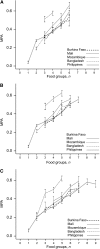Simple food group diversity indicators predict micronutrient adequacy of women's diets in 5 diverse, resource-poor settings
- PMID: 20881077
- PMCID: PMC2955880
- DOI: 10.3945/jn.110.123414
Simple food group diversity indicators predict micronutrient adequacy of women's diets in 5 diverse, resource-poor settings
Abstract
Women of reproductive age living in resource-poor settings are at high risk of inadequate micronutrient intakes when diets lack diversity and are dominated by staple foods. Yet comparative information on diet quality is scarce and quantitative data on nutrient intakes is expensive and difficult to gather. We assessed the potential of simple indicators of dietary diversity, such as could be generated from large household surveys, to serve as proxy indicators of micronutrient adequacy for population-level assessment. We used 5 existing data sets (from Burkina Faso, Mali, Mozambique, Bangladesh, and the Philippines) with repeat 24-h recalls to construct 8 candidate food group diversity indicators (FGI) and to calculate the mean probability of adequacy (MPA) for 11 micronutrients. FGI varied in food group disaggregation and in minimum consumption required for a food group to count. There were large gaps between intakes and requirements across a range of micronutrients in each site. All 8 FGI were correlated with MPA in all sites; regression analysis confirmed that associations remained when controlling for energy intake. Assessment of dichotomous indicators through receiver-operating characteristic analysis showed moderate predictive strength for the best choice indicators, which varied by site. Simple FGI hold promise as proxy indicators of micronutrient adequacy.
Conflict of interest statement
Author disclosures: M. Arimond, D. Wiesmann, E. Becquey, A. Carriquiry, M. C., Daniels, N. Fanou-Fogny, M. L. Joseph, G. Kennedy, Y. Martin-Prevel, and L. E. Torheim, no conflicts of interest. M. Deitchler is an employee of by AED.
Figures


References
-
- Kennedy E, Meyers L. Dietary reference intakes: development and uses for assessment of micronutrient status of women: a global perspective. Am J Clin Nutr. 2005;81S:1194–7 - PubMed
-
- Torheim LE, Ferguson E, Penrose K, Arimond M. Women in resource-poor settings are at risk of inadequate intakes of multiple micronutrients. J Nutr. 2010;140:2051–8 - PubMed
-
- Dietary Reference Intakes IOM Applications in dietary assessment. Washington, DC: National Academies Press; 2000 - PubMed
-
- Bryce J, Coitinho D, Darton-Hill I, Pinstrup-Anderson P. Maternal and child undernutrition: effective action at national level. Lancet. 2008;371:510–26 - PubMed
-
- WHO Preparation and use of food-based dietary guidelines. WHO Technical Report Series No. 880. Geneva: WHO/FAO; 1998 - PubMed
Publication types
MeSH terms
Substances
Grants and funding
LinkOut - more resources
Full Text Sources

